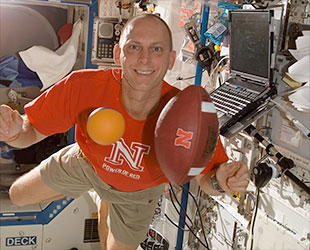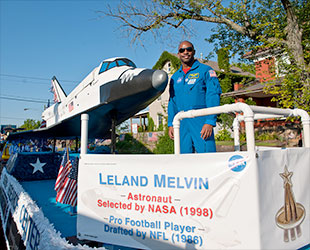Nov. 5, 2015 — NASA this week announced it would soon begin accepting applicants for its next class of astronauts, enticing potential candidates with the chance to "advance a future human mission to Mars."
But with the space agency's schedules pegging a journey to the Red Planet in the mid-2030s timeframe, it may fall to even more future recruits to become the first astronauts to walk on Mars.
That's not to say there aren't opportunities to make history as a new NASA astronaut. Although there have been more than 365 NASA astronauts to date, there remains firsts to be achieved and all that you have to do to claim them is get chosen for the corps.
With more than 6,000 applications for the last recruitment, being selected may be no small feat. But if you can match the requirements and rise above the rest, you could enter the history books on the same day you report to NASA for basic training.
Born in the USA
NASA states in its requirements that applicants "must be citizens of the United States."
Of course, you needn't be born in the country to be a U.S. citizen (and NASA accepts valid dual-citizenship, too), but if you do hail from the 50 states, you may be able to claim a first by just identifying your birthplace.
In NASA's 56 years of astronaut selections, no candidates have originated from Alaska, Nevada or Wyoming. Some have come close — space shuttle pilot Bill Oefelein grew up in Anchorage after being born in Virginia, for example — but those three remaining states are still without their own homegrown space hero.
(There's a fourth state, Vermont, which is the birthplace of a former NASA astronaut who never flew in space, and so the state is still waiting for its first resident to launch.)

NASA astronaut Clay Anderson represents his birth state aboard the space station with a University of Nebraska football. (NASA) |
So, if you happen to be native-born Alaskan, Nevadian or Wyomian and you become an astronaut, you're likely good as written into the state's history rolls.
Need an example? Clay Anderson, who reapplied 15 times before NASA selected him in 1998, is the first astronaut to come from Nebraska. For that distinction (and his time off the planet), he's been praised by the state's officials, had a documentary tell the story of his life by the state's public broadcasting station and even had Feb. 29, 2008 declared "Clay Anderson Day" in Nebraska.
Professional experience
NASA requires its qualified astronaut candidates to have a bachelor's degree in engineering, mathematics, biological or physical science and have three years of "professional experience" (or 1,000 hours of pilot-in-command time in jet aircraft).
You may believe that limits astronauts to being engineers, medical doctors and military pilots, but there have been a number of space explorers who have come to NASA from unexpected prior employment.
Take, for example, Leland Melvin, who was chosen in the same astronaut class as Anderson. Melvin has degrees in chemistry and materials science engineering, but before he was recruited by NASA, he was drafted by the Detroit Lions to play professional football.
Injuries early in his playing career altered his professional trajectory from the field goal to the frontier, leading Melvin to launch to space on two shuttle missions. To date, he is the only NFL football player orbit the Earth, giving a whole new meaning to "touchdown."

Astronaut Leland Melvin takes part in the 2010 Pro Football Hall of Fame Festival Timken Grand Parade in Canton, Ohio. (NASA) |
But Melvin is not alone when it comes to astronauts with notable prior professions.
Tom Jones, selected in 1990, spied down on Earth during four spaceflights, but not before working for the CIA. Rick Linnehan had a private veterinary practice before entering NASA's ranks in 1992. Megan Behnken, who was chosen in 2000 and helped service the Hubble Space Telescope, first focused on the seas as an oceanographer.
Mario Runco also studied the oceans prior to entering the astronaut corps in 1987, but even before that he trained at the New Jersey State Police Academy and worked as a state trooper (earning him the nickname "Trooper" later in life).
And then there's Leroy Chiao's first job, serving up meals at McDonald's, 29 years before the fast food chain proudly served him with a Big Mac and french fries on his return to Earth after nearly 200 days aboard the International Space Station.
There are numerous occupations still waiting for their first rep at NASA. You could be the first professional baseball player-turned-astronaut, or perhaps the first paleontologist-turned-flight engineer, or even maybe the first Uber driver-turned-commercial crew spacecraft pilot.
First of a kind
NASA states that it selects qualified astronaut candidates "from a diverse pool of U.S. citizens with a wide variety of backgrounds," and that it does.
The 1978 class of astronauts included Sally Ride, the first American woman to fly into space; Guion Bluford, the first black U.S. astronaut to fly in space; and Ellison Onizuka, the first Asian American in space.
John Herrington, chosen in 1996, become the first enrolled member of a Native American tribe to fly into space. Ellen Ochoa, now the director of the Johnson Space Center in Houston, was the first hispanic woman to launch to space three years after she joined NASA's corps in 1990.
Mark Lee and Jan Davis, selected in 1984 and 1987, met as NASA astronauts and became the first married couple to be in space at the same time. And Scott Kelly, who is now onboard the space station for a nearly year-long stay, was recruited as an astronaut at the same time as his twin brother, Mark, in 1996, becoming the first siblings to lift off the Earth.
To be fair, most of the firsts in this category have already happened. After half a century of U.S. human spaceflight, the sexes, races and major religions (and overlaps therein) have been represented in the composition of the astronaut corps. But there is at least one more first that is still to be claimed.
Russia's space agency, Roscosmos has already recruited two second-generation cosmonauts: Roman Romanenko and Sergei Volkov, the latter of whom is now in space on his third mission. But to date, no NASA astronaut's son or daughter has gone on to become a NASA astronaut.

NASA astronaut Owen Garriott (right) greets his son Richard after Richard's landing from the space station. (Space Adventures) |
Richard Garriott, the son of Skylab and shuttle astronaut Owen Garriott (chosen in 1965) flew to the station in 2008, but as a self-funded spaceflight participant. (He wanted to apply to NASA but was told that his poor eyesight would be an issue, long before the space agency accepted laser-corrected vision.)
Perhaps the closest NASA has come to its own second-generation astronaut (at least as has been acknowledged publicly) was in 2013 when Amy Ross, daughter of record-setting seven-time astronaut Jerry Ross, was an applicant for that year's class.
The younger Ross, who is a spacesuit engineer in her own right, wasn't chosen then. Will she re-apply now?
Personal history
If you weren't born in an astronaut-absent state, don't have an unusual job or aren't the offspring of a prior candidate, you might still put your years on Earth to good effect.
"There are no age restrictions," Christina Hammock Koch, a member of the 2013 class, wrote in a Facebook Q&A on Wednesday (Nov. 4). "The average age [is] 34."
To date, the youngest people to report for NASA astronaut training were Sally Ride and Tamara "Tammy" Jernigan, who were 26 when they were selected in 1978 and 1985, respectively. Ride went on to become the youngest U.S. astronaut in space at the age of 32 years and 23 days old.

Sally Ride, America's first woman in space, is also the youngest U.S. astronaut to fly and was only 26 when selected. (NASA) |
If you're already out of your 20s, then there's still the other end of the spectrum.
The oldest astronaut at the time of her appointment was Barbara Morgan at 46 (Morgan was originally chosen to be the backup to Teacher-In-Space Christa McAuliffe in 1985, but it was not until 1998 that she was assigned as a NASA astronaut).
The oldest NASA astronaut to fly into space was original Mercury pilot John Glenn, who returned to orbit in 1998 at the age of 77 (before him, Story Musgrave held the record at age 61).
Of course, Glenn is recorded in the history books for more than just his septuagenarian status, he being the first U.S. astronaut to orbit the Earth in 1962. And, so may be the case for NASA's 2017 class of astronaut candidates, who may trail blaze their own path into history as they advance NASA's journey to Mars.
